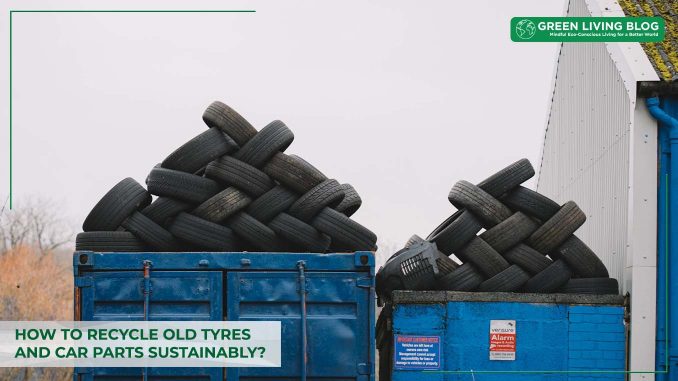
Recycling old tyres and car parts is an essential practice that safeguards our environment by reducing rampant waste.
It’s a problem lamented by many, but this recycling process, when done sustainably, metamorphoses these ‘wastes’ into valuable resources, with plenty of ingenious applications.
Getting started with tyre recycling, for instance, may seem puzzling, but it is quite straightforward and the solutions are within your reach. You can use these old tyres for garden decor like plant pots or use them to create outdoor furniture.
For larger scale efforts, tyres can be repurposed into rubberized asphalt for road construction, and various rubber products.
When it comes to car parts, reuse and recycling can be a little more intricate.
A variety of components from radiators, batteries, transmissions, and much more can be reused in other vehicles or recycled into new products. Some parts such as metal scraps and glass can be integrated into diverse industries.
You can make this sustainable journey of recycling old tyres and car parts easier through reliable partners like Dirt Cheap Rubbish Removal.
They can provide the necessary services to ensure your old tyres and car parts are efficiently and sustainably recycled, helping you contribute positively to environmental conservation.
Why Recycle Auto Parts Sustainably?

It’s crucial to understand that recycling car parts and tyres is not just an environmentally-friendly practice but also a key component to minimizing waste production and promoting sustainability. Thanks to tyre recycling initiatives, about 4 million tonnes of end-of-life tires are collected every year.
Reducing Environmental Impact
Discarded tyres barely decompose; they wreak havoc by clogging landfills and releasing harmful toxins. By recycling old tyres, you’re playing a significant role in keeping the environment clean and reducing pollution.
Sustainable Resource Utilization
Recycling car parts reduces the unending need for raw materials for new parts manufacture. By getting innovative and reusing these components, you help conserve natural resources and reduce resource depletion.
Job Creation Opportunities
The process of recycling tires and auto parts can create numerous jobs within the community. This doesn’t only improve people’s livelihoods but also fosters economic growth at a local level.
Promoting Circular Economy
Sustainable recycling contributes to a circular economy where resources are used repeatedly instead of being discarded after use. This drive ensures long-term sustainability while maintaining environmental integrity.
Assessing the Worth of Old Tyres
When it comes to repurposing old tires, it’s important to first take a moment to determine their worth. Regardless of whether you’re a car enthusiast or a casual driver, the condition and type of your tires play a significant role in this process.
If your tires are relatively new and show minimal signs of wear, they can be valuable assets for reuse.
Such tyres can be cleaned, remolded, or even sold as second-hand tyres. However, if your tires are degraded or worn out, they might only have worth as scrap material.
- Check tread depth: A tyre with a substantial remaining tread depth has high recyclability potential.
- Evaluate sidewall condition: If your tyre sidewalls are free from cuts, cracks or bulges, these tyres are ideal for reuse.
- Identify punctures or repairs: Tyres with multiple punctures or repairs can be difficult to recycle but might still hold some value for creative DIY projects.
In case none of these conditions apply to your old tyres, don’t despair. There are plenty of other sustainable avenues to explore when disposing of them. On the other hand, for those with vintage or high-performance cars, your old tyres could potentially be a goldmine if they’re rare or hard-to-find sizes.
To ultimately determine their worth though, you may need to approach professional tyre recycling centres. They’ll evaluate the condition of your old tyres and guide you on the best possible options for recycling them sustainably.
Dismantling Car Parts Properly

The first step to recycling old tyres and car parts sustainably is proper dismantling. You need to separate the different elements of each part so they can be recycled accordingly.
In the European Union, about 95% of a vehicle, by weight, can be recycled. However, certain parts require specific processes. For example, tires need deflating and removing. Engine parts often contain hazardous materials that should be contained and dealt with safely.
- Wear protective gear: Old car parts can be sharp, dirty and potentially harmful. Always wear gloves, durable clothing, and safety glasses when dismantling car parts.
- Use the correct tools: The right tool for the job will make all the difference. Screwdrivers, wrenches, pliers, and cutters are just a few tools you might need.
- Follow regulatory guidelines: Be sure you know your local regulations regarding disposal of waste material to ensure legal compliance.
Once you’ve properly dismantled the car parts, you can start the recycling process. Metals such as steel and aluminum are highly recyclable and are typically easy to recycle in most areas. For non-metal components such as rubber or plastic, consider reaching out to local recycling centers or looking for creative repurposing opportunities.
Sustainability in Metal Recycling

Metal components make up a significant portion of old tyres and car parts. With approximately 1 billion tires reaching their end of their useful life every year globally, embracing sustainable metal recycling is crucial.
Benefits of Metal Recycling
Recycling metals from discarded tyres and car parts helps in conserving natural resources. It limits the extraction of new ores, curbing environmental degradation.
Metal Extraction Process
In the metal extraction process, tyres are shredded into smaller pieces. Magnets are then used to separate the metal parts for recycling.
Promoting Energy Efficiency
Recycling metals from old car parts is energy-efficient. It uses significantly less energy compared to mining and refining new metals, reducing greenhouse gas emissions.
Revenue Generation Opportunities
The recycled metals can be sold commercially, creating viable revenue-generation opportunities contributing to economic growth.
Reducing Landfill Waste
Finally, metal recycling significantly reduces landfill waste. Discarded tyres and car parts won’t end up rotting in dumpsites, leading to better waste management and aiding in pollution control.
Turning tyres into Rubber
The process of transforming old tyres into usable rubber presents an outstanding approach to making use of waste while also conserving natural resources. It offers an organized method for recycling tyres and reducing their negative impacts on the environment.
Recycling four tires reduces CO2 by about 323 pounds, which is equivalent to 18 gallons of gasoline. Aside from lessening environmental pollution, flipping tyres into rubber ensures the valuable materials they contain do not go to waste.
The transformed rubber can be utilized in a variety of ways, for instance:
- In making playground surfaces: Rubber crumbs are often used in creating safe, shock-absorbent, and durable play surfaces for children.
- In constructing roads: Rubberized asphalt is considered more resilient and capable of minimizing road noise.
- In producing rubber mulch: This is a popular choice for gardening enthusiasts as it prevents weed growth and retains moisture.
This method provides several benefits beyond mere recycling. It preserves landfill spaces, mitigates the risk associated with illegal dumping of tyres, and curbs the spread of diseases by eradicating mosquito breeding habitats often found within discarded tyres.
Your creativity is your only limit when identifying new uses for this recycled material. By converting old tyres into reusable rubber products, you contribute significantly to sustainable living while also saving money and conserving valuable materials.
Creating Art from Autoparts

Using recycled steel from tire wire saves approximately 75% of the energy required to produce virgin steel from raw materials. This significant saving graces not only our environment but also gives your creativity a recyclable canvas. Explore the realm of artistic exploration using old car parts.
Begin your transformation journey by observing these discarded materials. The possibilities are endless, ranging from small accent pieces to large-scale installations. Whether painting on tires or welding together auto parts to create sculptures, you are the beholder of your artistic masterpiece.
- Inventive Sculptures: Combine different parts to create visual representations.
- Tire Planters: Carve out tires, paint them, and use them as plant holders.
- Spare Part Furniture: Utilize seats, springs, and other components to fabricate unique furniture.
The beauty of creating art from car parts is its openness to interpretation. Every creation reflects a story; yours will be one of sustainability and resourcefulness. It showcases that anyone can transform trash into valuable items with potent imaginations and ethical intentions.
Besides nurturing your creative spirits, recycling car parts sustainably reduces landfill burdens and promotes environmental health. It’s a winning situation where art meets sustainable practices enriching your lifestyle while helping the planet.
Responsible Disposal Post-Processing
As a responsible car owner, disposing of your old tyres and car parts in an eco-friendly manner is essential. The challenge lies in doing it sustainably. It’s estimated that the United States alone generates around 290 million scrap tires annually.
Safety and environmental consciousness are prioritized when determining the optimal disposal method. Moving beyond traditional methods of either dumping or incineration, new innovative strategies of recycling and repurposing have gained popularity.
Initiatives such as tyre-derived fuel (TDF), rubberized asphalt for roadways, shoe soles and synthetic turf fields are innovative ways to recycle old tyres. Old car parts can be melted down and used as raw material for manufacturing industries.
![]()
Author Profile
- Passionate content creator, contributor, freelance writer and content marketing allrounder.
Latest entries
 Best practicesMarch 21, 202511 Practical Ways to Limit Your Exposure to Microplastic Pollution
Best practicesMarch 21, 202511 Practical Ways to Limit Your Exposure to Microplastic Pollution EnvironmentFebruary 27, 2025What is Asbestos and Who Does it Impact?
EnvironmentFebruary 27, 2025What is Asbestos and Who Does it Impact? Green GuidesFebruary 17, 202510 Inspiring Green Living Room Ideas and Trends You Can’t Miss
Green GuidesFebruary 17, 202510 Inspiring Green Living Room Ideas and Trends You Can’t Miss Best practicesJanuary 30, 2025Keeping It Clean: Smarter Ways to Deal with Toxic Trash in Cities
Best practicesJanuary 30, 2025Keeping It Clean: Smarter Ways to Deal with Toxic Trash in Cities






Leave a Reply
You must be logged in to post a comment.